[TABLE TALK] Canada forges bond with Korea and its own past
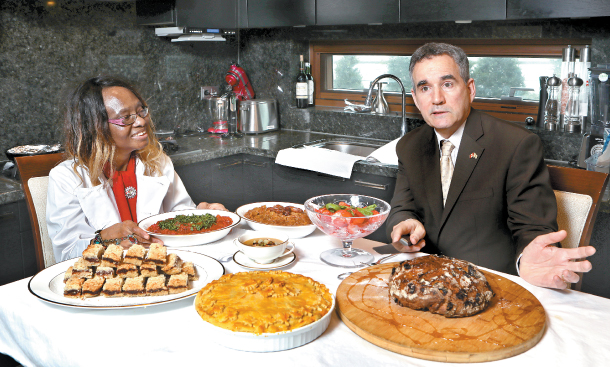
Ambassador of Canada to Korea, Michael Danagher, right, and his wife Stephanie Danagher discuss the history of First Nations and where the issue of indigenous people stand today in Canada over some of their favorite signature dishes of Canada during an interview at their residence in central Seoul on March 27. [PARK SANG-MOON]
We are asking these questions to ambassadors in Seoul for our latest public diplomacy series, “Table Talk.” The book, its author and what they say about the country is discussed over a table full of national dishes. What better way to start an exploration of a new land than through food, good writing and a personal guide dedicated to building bridges between countries - right here in Korea? - Ed.
“Orenda can’t be lost, just misplaced. The past and the future are present.”
These are the last words of “The Orenda,” a novel by Joseph Boyden that unravels around a Haudenosaunee girl, a Wendat leader and a Jesuit missionary in 17th-century North America.
Orenda is a term used throughout the novel to indicate “a life force” that the indigenous people believed to be present in humans, animals, rocks, trees and all that is in nature.
Boyden may not have the last word on the indigenous issue of Canada, and he certainly is not looking to, based on what he has told several media outlets, but the ending of his book begs the question of how much of what happened in Canada is present in everyday lives of Canadians today.
“There are people in Canada asking the question, are we really reconciled with our history because the reality was you had the European arrival in Canada that displaced people, it impacted their culture in a very disruptive way,” said Michael Danagher, ambassador of Canada to Korea. “And many of our greatest writers in Canada have addressed this issue. Of course, there are different types of opinions across Canada but people are committed to talking about them.”
“The Orenda” was the winner in Canada’s national radio program “Canada Reads” in 2014, triumphing over four other books defended by panelists for weeks.
The arrival of Jesuit missionaries in New France in 1611 and their eventual movement into the Huron Nation and other indigenous communities led to a severe decline of the population of the indigenous people in Canada, by way of diseases and conflicts that some experts argue were worsened by the French-British rivalry and their alliances with different indigenous groups.
“The question we’re asking now is what do the indigenous want,” he said. “But it’s a very sensitive discussion. You cannot assume that two indigenous people would hold the same opinion about a policy. And the second part to the question is, what do we do now that is different from what we’ve done in the past. We need to find the right tone to the conversation and it’s a very delicate process.”
As a diplomat, the same skill of finding the right tone in a conversation across different cultures is required everyday. And in the case for the Danaghers and some families in Canada, this skill is also practiced at home.
“So we have a little microcosm is my family in Canada because my father was an immigrant and my wife was an immigrant,” said the ambassador. “My mother comes from a French-Canadian family and they came to Canada in the 1630s. My dad came in 1953.”
“As an immigrant to Canada, I can say that I was given the opportunity to be myself,” said Stephanie Danagher, wife of the ambassador. “Canada is a place where you come in, and say I have an idea, you can go with your idea and it works or maybe it doesn’t work but you’re able to pick up your game.”
One of the common assumptions people make is that cultures are based on what is perceived on the outside.
“Just because somebody looks like us and talks like us that doesn’t necessarily mean they are us, even within our own societies,” she added. “You may say something with a tone or particular words and people can misunderstand.”
Although, admittedly, a misunderstanding of a word can be as harmless as a matrimonial cake.
“I grew up in Ontario and when we moved to British Columbia, somebody once said to me at a function, did you try the matrimonial cake?” said Michael Danagher. “I asked what’s that? And the person pointed at the dessert, at which point I said, you mean date squares, to which the person said what’s that? So even in Canada we call it different names.”
The Danaghers sat down with the Korea JoongAng Daily on March 27 at their residence in central Seoul to discuss the history of Canada and its peoples over bowls of split pea soup taken with cranberry honey walnut bread and tourtiere enjoyed with tomatoes chutney and apple and dates chutney. And, of course, date squares.
The following are edited excerpts from the interview with the ambassador.
Q. Tell us why you chose to introduce “The Orenda” for the Table Talk interview.
A. There were several reasons, one being that it reflects a part of the history of Canada which is not widely known and shows our country to have been home to much more drama and less “boring” than [outsiders] think. Additionally, many of the issues concern themes that are still relevant to modern Canada, such as the relationship between indigenous and newcomers’ cultures, impact of violence on society, technological change, substance abuse and suicide prevalence among indigenous peoples. I also thought the focus on shamanistic beliefs might be of interest to Koreans, for whom it has also been a part of their traditional culture.
What are your thoughts about the debate on the need to have an indigenous person tell the story of their people’s past?
It is important that all voices be heard, and particularly on issues which relate directly to any particular culture. Still, I do believe there is value in having different perspectives, and many insightful books have been written by those without indigenous background. In the case of “The Orenda,” in which the narrative voice changes from one protagonist to another, it would have been impossible to have this book without borrowing the voice of someone from another culture.
One trait that stands out about the book is the intensity of the violence depicted. Christophe, the French Jesuit missionary, in witnessing the practice of torture among warring groups of the indigenous, is reminded of consummate levels of violence in some practices in the Catholic inquisition.
I noted how both torture practised by the Wendat (as described in the book) and by the Inquisition were both seen in ritual and social terms. In the Inquisition, the “auto da fe” was practised as a way of bringing the victim back into the community, as an act of penance, and the torture described among the Wendat had an analogous purpose of diminishing the victims spirit as part of a process of absorbing their “power” (or “orenda”) into the community. However brutal, this was in some ways an act of communion between victim and victimizer, as the word used for the torture - “caress” - implies.
My other point is that there have been some who have decried references to this ritual torture as underscoring a stereotype of savagery. My view is that there is literary license at play here, and also that the equation of the worlds of the French and the Wendat in so many ways, along with the emphasis on their lack of mutual understanding, is an important part of the rhetoric of this book.
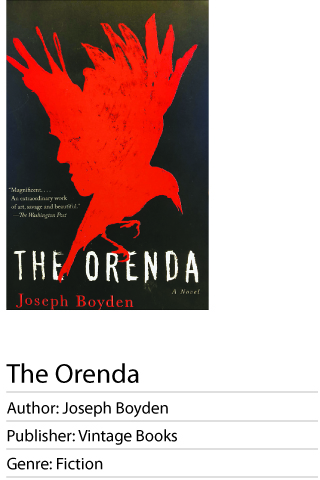
“The Orenda” by Joseph Boyden is set in the wilds of the 17th century North America when Jesuit missionaries ventured deeper into the territories of the Huron Nation, the Haudenosaunee and other indigenous groups of today’s Canada. It tells the story through three narrators, a missionary, a Wendat and a Haudenosaunee. The book was the winner in the “Canada Reads” national radio program in 2014.
It is frankly a complex and sensitive question. The current government has pledged to have a nation-to-nation relationship with Canada’s indigenous communities. Since the Truth and Reconciliation Commission’s final report in 2015, there has been an increased level of awareness among the broader Canadian population of the seriousness of issues facing its indigenous population.
I am reluctant to characterize any single response from the indigenous community, but it seems to be a mix of hope for progress, borne from the increasing sense of achievement by many of its members, to cynicism. Some of the indigenous people see a future in a modern Canada, while others are reinforcing or rediscovering their own traditions. Others still have held strongly to Christian traditions to which they have been introduced.
What about today’s dining experience is particularly Canadian?
I have chosen some items which would have appeared in my French-Canadian mother’s kitchen and for which Stephanie has mastered the preparation. These would have all been very traditional foods in Canada, and perhaps even enjoyed by the “Blackrobes” who appear in “The Orenda.”
Tourtiere is very traditional in French Canada and based on culinary traditions brought over from the time of settlement. It is often associated with Christmas, and, in my younger days, would be the dish eaten on Christmas Eve after return from Midnight Mass.
Split pea soup is also considered an iconic Canadian dish, again with French roots. I remember this as a lunch my mother would make in winter months, when we would walk home from school for lunch.
We were often frozen when we arrived, but we could smell the delicious soup as soon as we entered our house.
Going back to the history of nation-building in Canada, there were quite a few Canadians involved with Korea’s path to independence.
About 200 Canadians came to Korea as missionaries, scholars and reporters from 1888 during the late Joseon Dynasty (1392-1910) to 1945. A great number of Canadians contributed to Korea’s modernization in fields such as education and medicine, including James Scarth Gale, who translated “The Cloud Dream of the Nine” into English; Oliver Avison, who established the Severance Hospital; and Rosetta Hall, who laid the fountains of modern women’s medical science.
In particular, Frank Schofield, Robert Grierson, Archibald Barker, Stanley Martin and Frederick McKenzie were rewarded by the Korean government for their efforts to support the Korean independence movement. They provided their own homes and mission buildings as meeting places for independence activists, wrote articles and took pictures of the Korean manse movement, and exposed atrocities by the Japanese Imperial Army to the international society.
What is one bilateral project planned for the next few years that you are excited about?
Of special interest to me is the fact that we have 27,000 Canadians living in Korea, and they are contributing to the relationship in very positive ways. Equally, Canadians identifying Korean heritage represent one of the largest overseas Korean communities in the world.
I also want to work with different parts of Korea’s communities to promote exchanges with Canada - for example, with the relationship between our countries’ women-owned business sectors.
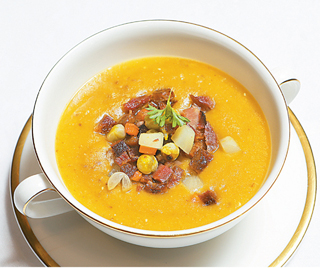
1. Heat one tablespoon of olive oil in a pan over medium heat.
2. Cook half an onion, diced, until slightly tender. Add two cloves of garlic, minced, and one pound of ham steak, diced.
3. Add six cups of chicken/vegetable stock, one pound of split peas, one bay leaf and add salt and pepper to taste. Cook over medium low heat for one and a half to two hours.
4. Add one or two carrots, diced, one or two stalks of celery, diced, and one russet of potato, peeled and diced, then cook for an additional 30-45 minutes.
5. Remove the bay leaf. Garnish with finely saute vegetable - peas, chopped carrots and potatoes and dices of baked ham.
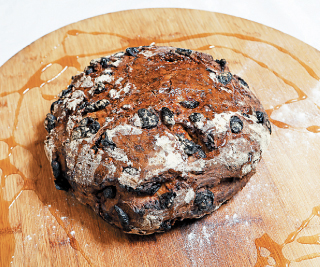
1. Place three cups of flour in a bowl. Carefully add a half teaspoon of instant yeast and two teaspoons of salt. Add one cup of cranberries and half a cup of chopped walnuts and toss.
2. Mix a quarter cup of honey with one and a half cups of water separately. Pour in and stir (not knead).
3. Cover the bowl and let the dough rise for 12-18 hours.
4. Preheat oven to 450 degrees Fahrenheit. Place the dough as a circular loaf on parchment paper. Loosely cover with plastic wrap and let it rise for 45 minutes. Preheat a pot in the oven.
5. Transfer the dough into the pot. Put the lid on and place the pot in the oven for 30 minutes.
6. Remove the lid and bake for another 15 minutes. Place on a rack to cool.
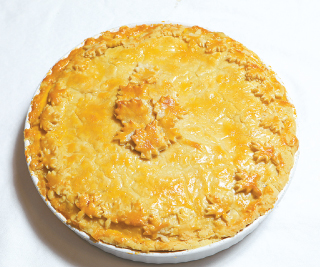
Pastry
Ingredients:
2 cups unbleached all-purpose flour
1/2 teaspoon kosher salt
2/3 cup butter or lard
6-7 tablespoons cold water
Directions:
1. In a large bowl, combine flour with the salt.
2. Cut in butter or lard until mixture is a roughly even crumbly texture.
3. Add water and blend just until dough comes together.
4. Shape into a rough disc, wrap and chill in the refrigerator. While pastry is chilling, prepare filling.
Filling
Ingredients:
1 pound ground pork
1 pound ground beef
1 small onion finely chopped
1 clove garlic finely minced
2 large potatoes, chopped
2 cups mushrooms, chopped
2 cups carrots, chopped
1/2 teaspoon poultry seasoning
1/2 teaspoon ground cinnamon
1/4 teaspoon ground cloves
1/4 teaspoon ground nutmeg
1/4 teaspoon kosher salt
1/8 teaspoon pepper
1 egg for glazing
Directions:
1. Cook potatoes in a pot of water until tender, about 12 minutes. Reserve 1/2 cup of potato water and drain the rest. Mash potatoes and set aside.
2. In a large skillet, cook the onion, garlic beef and pork over medium heat until no longer pink. Drain off excess fat.
3. Combine the seasonings in a small bowl and add to the meat mixture in the skillet.
4. Add the reserved potato water. Mix in well and simmer over low heat for about 10 minutes until the liquid is absorbed. Remove the pan from heat, stir in mashed potatoes, and set aside to cool.
Putting them together
1. Preheat oven to 400°F/205°C.
2. On lightly floured work surface, roll out 1 of the pastry discs to generous 1/8-inch (3 mm) thickness; fit into 9-inch (23 cm) pie plate.
3. Trim to fit, leaving 3/4-inch (2 cm) overhang. Scrape filling into pie shell, pressing down lightly to pack.
4. Whisk egg yolk with 1 tsp water; brush some over edge of pastry.
5. Roll out remaining pastry disc to generous 1/8-inch (3 mm) thickness; fit pastry over filling.
6. Trim to fit, leaving 3/4-inch (2 cm) overhang; fold overhang under and flute edge.
7. Cut decorative shapes from pastry scraps.
8. Brush some of the remaining egg mixture over pastry; arrange shapes over top. Brush top all over with some of the remaining egg mixture; cut steam vents in top.
9. Bake on rimmed baking sheet on bottom rack of 375F (190C) oven until filling is bubbly and bottom is golden, loosely covering with foil if top is browning too quickly, about 1 hour. Let cool in pan for 10 minutes.
BY ESTHER CHUNG [chung.juhee@joongang.co.kr]










with the Korea JoongAng Daily
To write comments, please log in to one of the accounts.
Standards Board Policy (0/250자)